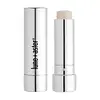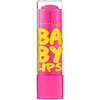What's inside
What's inside
 Key Ingredients
Key Ingredients

 Benefits
Benefits

 Concerns
Concerns

 Ingredients Side-by-side
Ingredients Side-by-side

Polybutene
Hydrogenated Polyisobutene
EmollientOctyldodecanol
EmollientPolyethylene
AbrasiveHydrogenated Poly(C6-14 Olefin)
EmollientCaprylic/Capric Triglyceride
MaskingDicalcium Phosphate
AbrasiveMicrocrystalline Wax
Emulsion StabilisingSynthetic Wax
AbrasiveStearalkonium Bentonite
Gel FormingAscorbic Acid
AntioxidantTocopheryl Acetate
AntioxidantPunica Granatum Pericarp Extract
Skin ConditioningCurcuma Longa Root Extract
MaskingRuby Powder
Skin ConditioningPentaerythrityl Tetra-Di-T-Butyl Hydroxyhydrocinnamate
AntioxidantPropylene Carbonate
SolventSynthetic Fluorphlogopite
Silica
AbrasiveBHT
AntioxidantTin Oxide
AbrasiveCI 77891
Cosmetic ColorantIron Oxides
CI 42090
Cosmetic ColorantCI 19140
Cosmetic ColorantCI 15850
Cosmetic ColorantCI 45410
Cosmetic ColorantMica
Cosmetic ColorantCI 77491
Cosmetic ColorantPolybutene, Hydrogenated Polyisobutene, Octyldodecanol, Polyethylene, Hydrogenated Poly(C6-14 Olefin), Caprylic/Capric Triglyceride, Dicalcium Phosphate, Microcrystalline Wax, Synthetic Wax, Stearalkonium Bentonite, Ascorbic Acid, Tocopheryl Acetate, Punica Granatum Pericarp Extract, Curcuma Longa Root Extract, Ruby Powder, Pentaerythrityl Tetra-Di-T-Butyl Hydroxyhydrocinnamate, Propylene Carbonate, Synthetic Fluorphlogopite, Silica, BHT, Tin Oxide, CI 77891, Iron Oxides, CI 42090, CI 19140, CI 15850, CI 45410, Mica, CI 77491
Polybutene
Octyldodecanol
EmollientIsopropyl Myristate
EmollientPetrolatum
EmollientEthylhexyl Methoxycinnamate
UV AbsorberPolyethylene
AbrasiveOzokerite
Emulsion StabilisingEthylhexyl Salicylate
UV AbsorberButyrospermum Parkii Butter
Skin ConditioningDiisostearyl Malate
EmollientCandelilla Cera
EmollientVp/Hexadecene Copolymer
Silica Dimethyl Silylate
EmollientParfum
MaskingCalcium Aluminum Borosilicate
Pentaerythrityl Tetra-Di-T-Butyl Hydroxyhydrocinnamate
AntioxidantTocopherol
AntioxidantTocopheryl Acetate
AntioxidantAlumina
AbrasiveAroma
Silica
AbrasiveIsopropyl Palmitate
EmollientPentaerythrityl Tetraisostearate
EmollientLimonene
PerfumingSynthetic Fluorphlogopite
Calcium Sodium Borosilicate
Benzyl Benzoate
AntimicrobialCentella Asiatica Extract
CleansingAluminum Hydroxide
EmollientCitral
PerfumingLinalool
PerfumingHexyl Cinnamal
PerfumingTin Oxide
AbrasiveGeraniol
PerfumingEugenol
PerfumingAloe Barbadensis Extract
Skin ConditioningMel
EmollientCalcium Pantothenate
Ascorbic Acid
AntioxidantDimethicone
EmollientSodium Chondroitin Sulfate
Skin ConditioningAtelocollagen
Skin ConditioningCI 77891
Cosmetic ColorantMica
Cosmetic ColorantCI 45410
Cosmetic ColorantCI 77491
Cosmetic ColorantCI 77492
Cosmetic ColorantCI 77499
Cosmetic ColorantCI 15850
Cosmetic ColorantCI 45380
Cosmetic ColorantCI 19140
Cosmetic ColorantCI 42090
Cosmetic ColorantCI 15985
Cosmetic ColorantCI 75470
Cosmetic ColorantPolybutene, Octyldodecanol, Isopropyl Myristate, Petrolatum, Ethylhexyl Methoxycinnamate, Polyethylene, Ozokerite, Ethylhexyl Salicylate, Butyrospermum Parkii Butter, Diisostearyl Malate, Candelilla Cera, Vp/Hexadecene Copolymer, Silica Dimethyl Silylate, Parfum, Calcium Aluminum Borosilicate, Pentaerythrityl Tetra-Di-T-Butyl Hydroxyhydrocinnamate, Tocopherol, Tocopheryl Acetate, Alumina, Aroma, Silica, Isopropyl Palmitate, Pentaerythrityl Tetraisostearate, Limonene, Synthetic Fluorphlogopite, Calcium Sodium Borosilicate, Benzyl Benzoate, Centella Asiatica Extract, Aluminum Hydroxide, Citral, Linalool, Hexyl Cinnamal, Tin Oxide, Geraniol, Eugenol, Aloe Barbadensis Extract, Mel, Calcium Pantothenate, Ascorbic Acid, Dimethicone, Sodium Chondroitin Sulfate, Atelocollagen, CI 77891, Mica, CI 45410, CI 77491, CI 77492, CI 77499, CI 15850, CI 45380, CI 19140, CI 42090, CI 15985, CI 75470
 Reviews
Reviews

Ingredients Explained
These ingredients are found in both products.
Ingredients higher up in an ingredient list are typically present in a larger amount.
Ascorbic Acid is is pure Vitamin C. This form makes up the largest amount of vitamin C found naturally in our skin.
Not only is vitamin C great for your overall health and immune system, it also has plenty of benefits on your skin.
Vitamin C is best used for brightening skin. It improves dark spots, acne scars, and hyperpigmentation. This is because it blocks the process of skin darkening when exposed to UV.
Remember: Vitamin C should not replace sunscreen!
Your skin uses vitamin C to build collagen. Collagen is one key component in having a strong skin barrier and plump skin. Vitamin C also plays a role in regulating collagen, thus making it effective in improving wrinkles and fine lines.
Ascorbic acid shows potent antioxidant activity. As an antioxidant, it helps fight free-radicals. Free-radicals are molecules that may damage your skin cells. These antioxidants also protect skin against UV damage.
The best formulations include Vitamin E and/or ferulic acid. These two ingredients help stabilize and provide a boost in the benefits of ascorbic acid. This is because ascorbic acid becomes unstable when exposed to UV and air. In fact, you can tell your ascorbic acid has oxidized when it turns an orange-yellow color.
Ascorbic acid is generally compatible with other ingredients. However, using ascorbic acid with other active ingredients might cause irritation. Two ingredients: copper ions and benzoyl peroxide, will inactivate ascorbic acid completely.
Read more about other types of Vitamin C:
Foods rich with vitamin C include oranges, strawberries, broccoli, bell peppers, and more. When consuming Vitamin C, your skin receives a portion of the nutrients.
Learn more about Ascorbic AcidCi 15850 is the pigment color red. It is an azo dye and created synthetically.
Azo dyes need to be thoroughly purified before use. This allows them to be more stable and longer-lasting.
This ingredient is common in foundations, lipsticks, and blushes. This color is described as brown/orangey red.
It has many secondary names such as Red 6 and Red 7. According to a manufacturer, Red 6 usually contains aluminum.
Learn more about CI 15850CI 19140 is also known as Tartrazine. Tartrazine is a synthetic dye used in cosmetics, foods, and medicine to add a yellow color.
Tartrazine is created from petroleum and is water-soluble.
Some people may experience allergies from this dye, especially asthmatics and those with an aspirin intolerance.
Learn more about CI 19140Ci 42090 is a synthetic dye created from petroleum. It is used to give a bright blue color to cosmetics, medicine, and food.
CI 45410 is a synthetic red-pigment and dye.
It often goes by both Red 28 or Red 27; manufacturers label both ingredients as CI 45410.
This dye is commonly found in makeup because it imparts a vivid color. Some types of this dye change color based on pH level and interaction with moisture:
Your skin has a natural pH of around 4.5 - 5.5.
According to the FDA, CI 45410 is not permitted for use in eye products.
Red 27 is a flourescein dye and commonly used as a fluorescent tracer in medicine.
Learn more about CI 45410Ci 77491 is also hydrated iron III oxide. It's sole purpose is to give a red/pink hue to products.
Iron III oxides are classified as inorganic chemicals for coloring.
Synthetically created Ci 77491 is considered safer than those naturally found. This is because the synthetically created version may contain less impurities. Iron oxides are generally non-toxic and non-allergenic.
Learn more about CI 77491Ci 77891 is a white pigment from Titanium dioxide. It is naturally found in minerals such as rutile and ilmenite.
It's main function is to add a white color to cosmetics. It can also be mixed with other colors to create different shades.
Ci 77891 is commonly found in sunscreens due to its ability to block UV rays.
Learn more about CI 77891Mica is a naturally occurring mineral used to add shimmer and color in cosmetics. It can also help improve the texture of a product or give it an opaque, white/silver color.
Serecite is the name for very fine but ragged grains of mica.
This ingredient is often coated with metal oxides like titanium dioxide. Trace amounts of heavy metals may be found in mica, but these metals are not harmful in our personal products.
Mica has been used since prehistoric times throughout the world. Ancient Egyptian, Indian, Greek, Roman, Aztec, and Chinese civilizations have used mica.
Learn more about MicaOctyldodecanol is a fatty alcohol. It is primarily used to enhance the texture of products.
As an emulsifier, Octyldodecanol helps prevent the oils and waters from separating. It also prevents ingredients from creating foam when shaken.
Octyldodecanol is created by reducing fatty acid to an alcohol.
Due to its high molecular weight, it does not get absorbed into the skin.
Learn more about OctyldodecanolPentaerythrityl Tetra-Di-T-Butyl Hydroxyhydrocinnamate (long name, huh?) is a synthetic antioxidant.
It is used to help stabilize other antioxidants or prevent the color from changing in a product.
As an antioxidant, it helps fight free-radical molecules. Free-radical molecules are capable of damaging our cells and other genetic material. Thus, antioxidants may reduce the signs of aging.
This ingredient is oil-soluble.
Learn more about Pentaerythrityl Tetra-Di-T-Butyl HydroxyhydrocinnamatePolybutene is used to help control the viscosity of a product. This just means it helps adjusts the texture.
It is a polymer and does not get absorbed into the skin due to its large size.
Studies found this ingredient did not irritate skin in concentrations below 15%.
Learn more about PolybutenePolyethylene is a synthetic ingredient that helps the skin retain moisture. It is a polymer.
It is also typically used within product formulations to help bind solid ingredients together and thicken oil-based ingredients. When added to balms and emulsions, it helps increase the melting point temperature.
Silica, also known as silicon dioxide, is a naturally occurring mineral. It is used as a fine, spherical, and porous powder in cosmetics.
Though it has exfoliant properties, the function of silica varies depending on the product.
The unique structure of silica enhances the spreadability and adds smoothness, making it a great texture enhancer.
It is also used as an active carrier, emulsifier, and mattifier due to its ability to absorb excess oil.
In some products, tiny microneedles called spicules are made from silica or hydrolyzed sponge. When you rub them in, they lightly polish away dead skin layers and enhance the penetration of active ingredients.
Learn more about SilicaSynthetic Fluorphlogopite is the synthethic version of mica. It consists of fluorine, aluminum and silicate.
Synthetic Fluorphlogopite is used to add volume to products.
It is considered non-irritating on the skin.
Learn more about Synthetic FluorphlogopiteTin Oxide is an inorganic oxide used to add opacity and volume to a product. In nature, it is already found in mineral form. The main ore of tin is an opaque and shiny mineral called casseterite.
Tin Oxide helps remove translucency in a product, or make it more opaque. Besides adding opacity, tin oxide is used for bulking to add volume.
Tocopheryl Acetate is AKA Vitamin E. It is an antioxidant and protects your skin from free radicals. Free radicals damage the skin by breaking down collagen.
One study found using Tocopheryl Acetate with Vitamin C decreased the number of sunburned cells.
Tocopheryl Acetate is commonly found in both skincare and dietary supplements.
Learn more about Tocopheryl Acetate